The Economics and Statistics Division maintains archives of previous publications for accountability purposes, but makes no updates to keep these documents current with the latest data revisions from Statistics Canada. As a result, information in older documents may not be accurate. Please exercise caution when referring to older documents. For the latest information and historical data, please contact the individual listed to the right.
<--- Return to Archive
For additional information relating to this article, please contact:
March 28, 2019NOVA SCOTIA POPULATION ESTIMATES BY COUNTY - JULY 1, 2018 Statistics Canada has released estimates of the population by county as of July 1, 2018. Provincial population estimates for July 1, 2018 were released in September and updated to January 1 on March 21st. These population estimates should not be confused with Census counts. Estimates of the population adjust for net undercoverage from the Census as well as incompletely enumerated Indian reserves. The current estimates are based on the results of the 2016 Census of the population and data back to 2006 have been revised.
In Nova Scotia, 10 of the 18 counties had population growth from July 1, 2017 to June 30, 2018. Halifax had the fastest growth at 2.02 per cent, followed by Annapolis at 1.26 per cent. There was also population growth in Yarmouth, Digby, Lunenburg, Kings, Hants, Cumberland, Antigonish, and Richmond counties. Population decline was the fastest in Guysborough county, followed by Queens, Pictou, Inverness, Shelburne and Colchester counties. There were smaller declines in Victoria and Cape Breton counties.
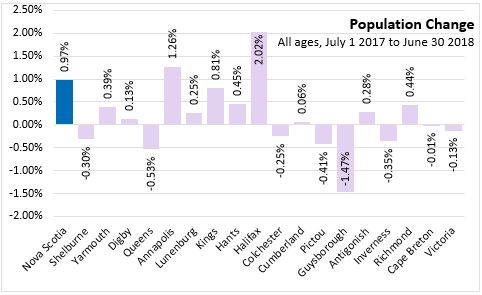
Halifax's population has risen to 430,505 or 44.8 per cent of the provincial population. Cape Breton county's population was 99,806 as of July 1st 2018 and had 10.4 per cent of the provincial population. The other three counties on Cape Breton Island (Inverness, Richmond and Victoria) accounted for 3.5 per cent of the provincial population (33,723). Counties in the North Shore economic region (Colchester, Cumberland, Pictou, Guysborough, and Antigonish) had a population of 153,090 or 15.9 per cent of the provincial total. Counties in the Annapolis Valley (Annapolis, Kings and Hants) had 127,664 residents or 13.3 per cent of Nova Scotia's population. The counties of Southern Nova Scotia (Shelburne, Yarmouth, Digby, Queens and Lunenburg) had a population of 115,154 or 12.0 per cent of the provincial total.
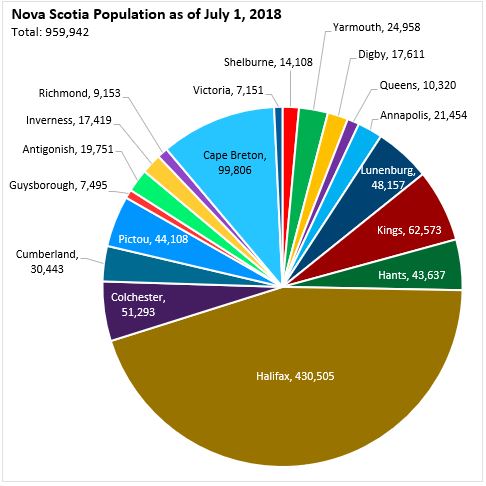
Nova Scotia's population growth has accelerated in the last three years. While much of this growth has been attributable to ongoing increases in the population of Halifax, there has also been a slowing pace of decline in several counties. The pace of population decline has slowed in Shelburne, Digby, Cumberland, Inverness, Cape Breton and Victoria counties. Several counties that had seen declines in recent years have seen an upturn in population growth, including Yarmouth, Annapolis, Lunenburg, Kings, Antigonish and Richmond.

Note: scales for all counties are set to 4,000 except Cape Breton (20,000) and Halifax (80,000).
Components of population change
Population estimates for counties change from one year to the next based on natural change (births, deaths), international migration (immigration, emigration, non-permanent residents), interprovincial migration (from one province to another) and intraprovincial migration (from one county of the province to another).
All counties except Halifax reported more deaths than births between July 1 2017 and June 30 2018. The natural population decline was largest in Cape Breton and smallest in Hants county. Halifax had a natural increase of 978.
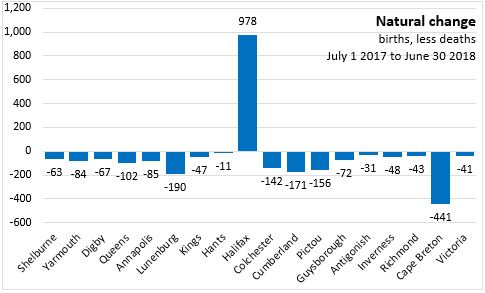
Immigration has contributed to the recent acceleration of Nova Scotia's population growth. Immigration was concentrated in Halifax with 4,353 immigrants added to the population. The next highest numbers of immigrants added were in Cape Breton and Kings counties.

Likewise, net changes in the number of non-permanent residents were concentrated in Halifax with 1,565. Cape Breton had the second highest number of non-permanent residents added, followed by Kings county.
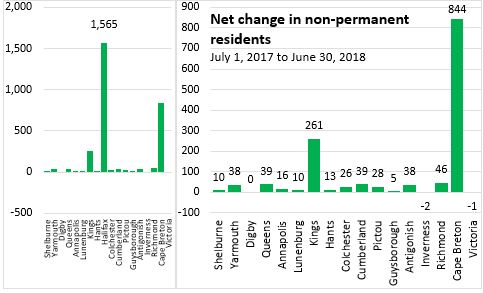
Overall international migration (including immigration, net non-permanent residents and emigration) contributed to population growth in every county. International migration was concentrated in Halifax, while Cape Breton and Kings counties also had large contributions to population growth from international sources.
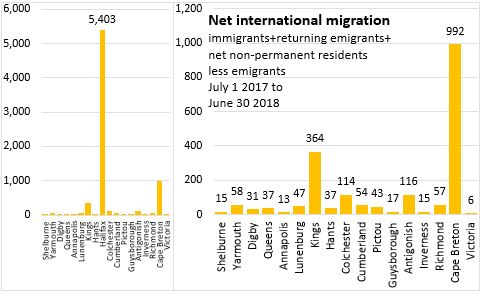
Interprovincial migration was also concentrated in Halifax with a net gain of 1,182 persons from other provinces. Most counties reported positive interprovincial migration in the last year, with Southern Nova Scotia and the Annapolis Valley regions reporting the largest gains. Interprovincial migration continues to be a drain on the population of Cape Breton county, but the pace of net out-migration has slowed in the last three years.
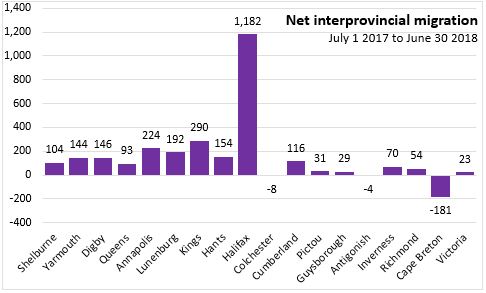
Net movements within the province have contributed to population increases in Halifax, Annapolis and Lunenburg counties, and to a lesser extent in Hants, Cumberland and Victoria.
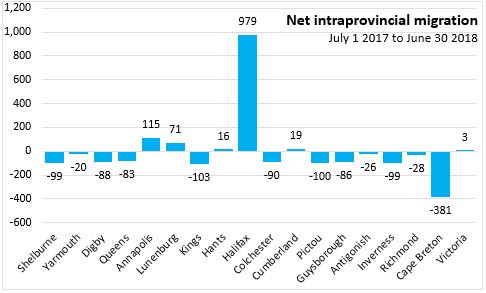
Age cohorts
As the baby boom cohort (born between 1946 and 1965) continue to expand the population over the age of 65 while fewer children are born, the share of population under the age of 14 is declining in many counties, especially in the North Shore region. However, the increases in other counties have helped to grow this age group over the last year. The population under the age of 14 increased in Southern Nova Scotia and Halifax. The highest share of youth in the population are found in Hants, Antigonish and Colchester counties.
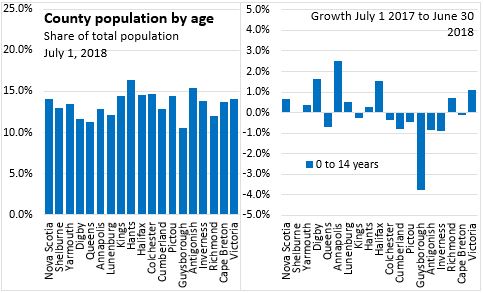
Populations aged 15 to 39 are also declining in many counties. However, growth of this age cohort in Halifax, Annapolis, Cape Breton and Kings counties has kept the size of this cohort growing for the province as a whole. The steepest declines in this population were reported in Guysborough, Victoria, and Pictou counties. The counties with the highest share of the population aged between 15 and 39 were Halifax and Antigonish.
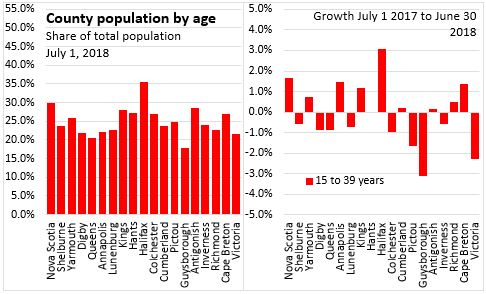
The population aged 40 to 64 is declining in every county except Halifax. This is the cohort from which large numbers of the baby boom are now aging past 65 years old. The share of 40 to 64 year olds in the population is relatively consistent across the province, but slightly higher in Queens, Digby, Shelburne and Guysborough counties.
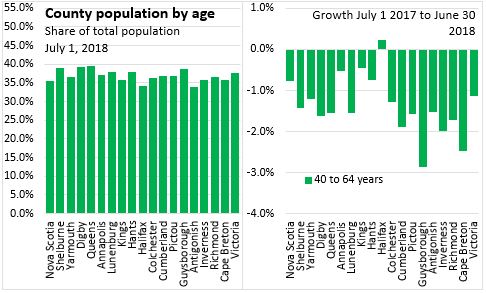
The population over the age of 65 is rising in every county as the baby boom continues to reach this threshold. The fastest growing populations aged 65 and over are in Antigonish, Hants and Halifax counties. The highest share of populations over 65 are found in Guysborough, Queens, and Richmond counties. The lowest shares of residents over age 65 are in Halifax and Hants counties.
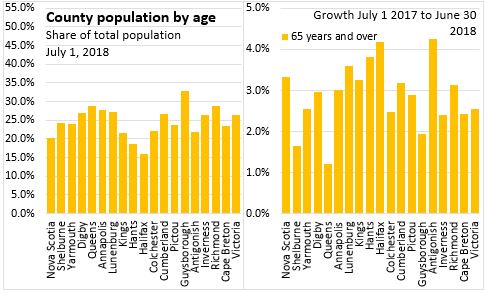
Cities
Population growth was faster in urban areas from July 1st 2017 to July 1st 2018. Halifax's population growth of 2.02 per cent is similar to growth in other Census Metropolitan Areas (CMA), where the national average growth was 1.77 per cent. Populations outside CMAs in Canada grew by 0.53 per cent, while Nova Scotia's population outside the CMA rose only 0.14 per cent.
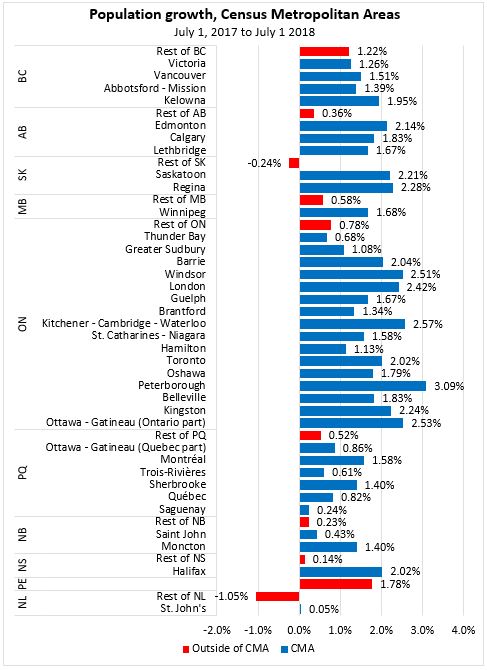
Source: Statistics Canada Tables 17-10-0139-01 (Counties), 17-10-0140-01(Components), 17-10-0135-01 (CMAs and CAs)
<--- Return to Archive